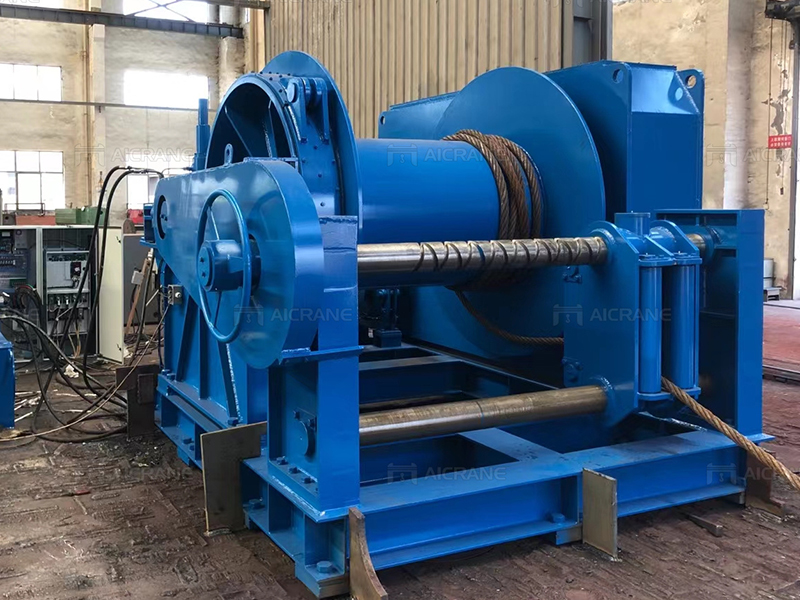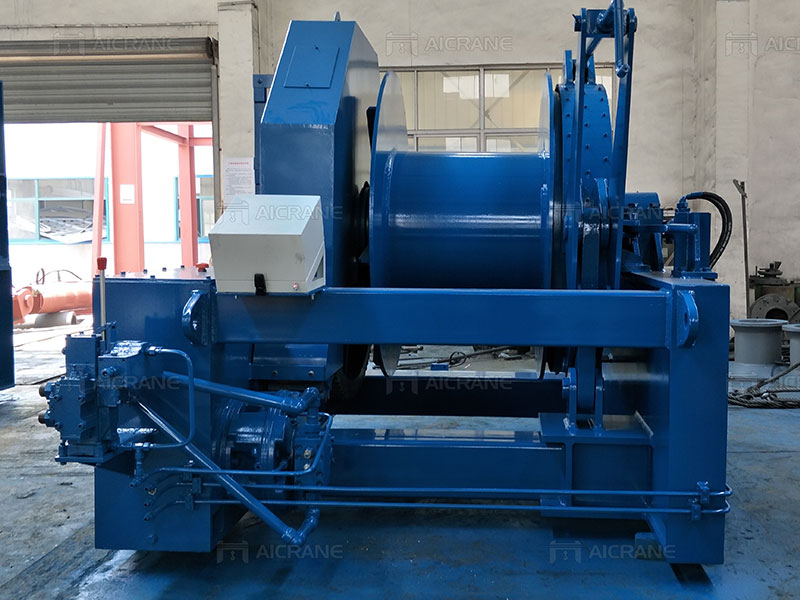The installation of a 50 ton winch is a complex and critical process that requires careful planning, precision, and adherence to safety standards. A 50 ton winch is a heavy-duty piece of machinery used for various applications, such as lifting and pulling heavy loads in industries like construction, mining, and marine. Proper installation is essential to ensure the winch operates efficiently, safely, and reliably throughout its lifespan. Here, we’ll explore the key steps involved in the installation of a 50 ton winch:

Site Assessment
Before commencing the installation process, a thorough site assessment is necessary. This involves evaluating the location where the winch will be installed, considering factors such as ground stability, load-bearing capacity, and available space. The site assessment helps identify any potential challenges or modifications needed for a successful installation.
Foundation Preparation
The foundation is a critical component of winch installation, providing stability and support for the heavy equipment. The foundation preparation involves excavating the designated area and pouring a concrete foundation of sufficient depth and strength to support the weight and operational forces of the 50 ton winch. The foundation dimensions and specifications should align with the manufacturer’s recommendations and engineering standards.
Anchor Bolts Installation
Anchor bolts are embedded in the concrete foundation during the pouring process. These bolts play a crucial role in securing the winch to the foundation. The installation of anchor bolts requires precise positioning to ensure alignment with the mounting holes on the winch base. Once the anchor bolts are in place, they are secured and leveled to provide a stable and secure foundation for the winch.
Winch Assembly
Before lifting the winch onto the foundation, it must be assembled according to the specifications of winch manufacturer. This involves attaching the drum, gear mechanisms, motor, and other components. Proper assembly ensures that all parts work together seamlessly, promoting the winch’s overall efficiency and safety during operation.
Lifting and Placement
The 50 ton winch, once assembled, is lifted using suitable lifting equipment, such as a crane or a hoist. Careful consideration is given to the weight distribution and balance during the lifting process to prevent damage to the winch or compromise its structural integrity. The winch is then carefully lowered onto the anchor bolts, ensuring a precise fit with the mounting holes.
Alignment and Leveling
Achieving proper alignment and leveling is crucial for the winch’s performance and longevity. Precision is required to align the mounting holes on the winch base with the anchor bolts. Once aligned, nuts are tightened onto the anchor bolts to secure the winch in place. Simultaneously, the winch is leveled to ensure that it operates on a horizontal plane, preventing issues such as misalignment of gears or uneven loading.
Connection to Power Source
The 50 ton winch requires a power source for its operation. Depending on the type of winch (electric, hydraulic, or pneumatic), the appropriate power connection is made. For electric winches, this involves connecting to the electrical supply, while hydraulic winches require connection to a hydraulic power unit. All electrical and hydraulic connections must be inspected to ensure they meet safety standards and regulations.

Control System Installation
The control system is a vital component that allows operators to manage the winch’s functions. The installation of the control system includes mounting the control panel and connecting it to the winch. The control system may include features such as variable speed control, emergency stop functions, and safety interlocks. Proper installation and testing of the control system are crucial for safe and efficient winch operation.
Safety Features and Testing
Winches are equipped with various safety features to protect both the equipment and personnel. These features may include overload protection, emergency braking systems, and limit switches. Before putting the winch into operation, a comprehensive testing process is conducted to ensure that all safety features are functioning correctly. This testing phase helps identify and address any issues before the winch is used for actual lifting or pulling tasks.
Commissioning and Operational Testing
Once the winch is installed, assembled, and all systems are in place, the commissioning process begins. This involves a series of operational tests to assess the winch’s performance under different conditions. Load testing is conducted to verify that the winch can handle its rated capacity safely and efficiently. Operational testing also includes checks for smooth operation, proper braking, and accurate control response.
Training and Documentation
Training operators and maintenance personnel is a critical aspect of the installation process. Operators need to be familiar with the winch’s controls, safety features, and operational procedures. Maintenance personnel should receive training on routine inspections, lubrication, and troubleshooting. Additionally, thorough documentation, including operation manuals and maintenance schedules, is provided to ensure proper ongoing care and use of the winch.
Regular Inspection and Maintenance
Post-installation, a routine inspection and maintenance schedule is established. Regular inspections help identify any signs of wear, damage, or potential issues that may arise during the winch’s operation. Maintenance tasks may include lubrication of moving parts, inspection of cables or ropes, and checking electrical or hydraulic components. Regular maintenance ensures the winch continues to operate safely and reliably.
Compliance with Regulations
Throughout the installation process, compliance with relevant safety and industry regulations is paramount. This includes adherence to local, national, and international standards for equipment installation, electrical connections, and safety features. Compliance ensures that the winch meets the necessary standards for operational safety and environmental impact.
In conclusion, the installation of a 50 ton winch involves a series of meticulous steps to ensure the equipment’s proper functioning, safety, and longevity. From site assessment and foundation preparation to assembly, lifting, and testing, each step requires precision and adherence to industry standards. The successful installation of a 50 ton winch not only involves the physical placement of the equipment but also encompasses comprehensive testing, training, and ongoing maintenance to guarantee its reliable performance in various lifting and pulling applications.